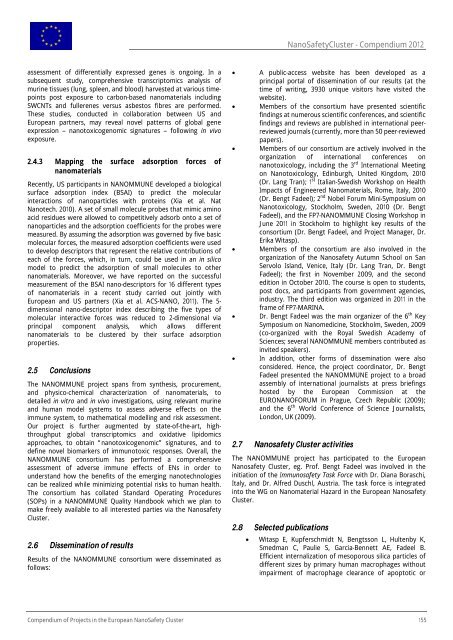Timing, hosts and locations of (grouped) events of NanoImpactNet
Timing, hosts and locations of (grouped) events of NanoImpactNet
Timing, hosts and locations of (grouped) events of NanoImpactNet
You also want an ePaper? Increase the reach of your titles
YUMPU automatically turns print PDFs into web optimized ePapers that Google loves.
assessment <strong>of</strong> differentially expressed genes is ongoing. In a<br />
subsequent study, comprehensive transcriptomics analysis <strong>of</strong><br />
murine tissues (lung, spleen, <strong>and</strong> blood) harvested at various timepoints<br />
post exposure to carbon-based nanomaterials including<br />
SWCNTs <strong>and</strong> fullerenes versus asbestos fibres are performed.<br />
These studies, conducted in collaboration between US <strong>and</strong><br />
European partners, may reveal novel patterns <strong>of</strong> global gene<br />
expression – nanotoxicogenomic signatures – following in vivo<br />
exposure.<br />
2.4.3 Mapping the surface adsorption forces <strong>of</strong><br />
nanomaterials<br />
Recently, US participants in NANOMMUNE developed a biological<br />
surface adsorption index (BSAI) to predict the molecular<br />
interactions <strong>of</strong> nanoparticles with proteins (Xia et al. Nat<br />
Nanotech. 2010). A set <strong>of</strong> small molecule probes that mimic amino<br />
acid residues were allowed to competitively adsorb onto a set <strong>of</strong><br />
nanoparticles <strong>and</strong> the adsorption coefficients for the probes were<br />
measured. By assuming the adsorption was governed by five basic<br />
molecular forces, the measured adsorption coefficients were used<br />
to develop descriptors that represent the relative contributions <strong>of</strong><br />
each <strong>of</strong> the forces, which, in turn, could be used in an in silico<br />
model to predict the adsorption <strong>of</strong> small molecules to other<br />
nanomaterials. Moreover, we have reported on the successful<br />
measurement <strong>of</strong> the BSAI nano-descriptors for 16 different types<br />
<strong>of</strong> nanomaterials in a recent study carried out jointly with<br />
European <strong>and</strong> US partners (Xia et al. ACS-NANO, 2011). The 5dimensional<br />
nano-descriptor index describing the five types <strong>of</strong><br />
molecular interactive forces was reduced to 2-dimensional via<br />
principal component analysis, which allows different<br />
nanomaterials to be clustered by their surface adsorption<br />
properties.<br />
2.5 Conclusions<br />
The NANOMMUNE project spans from synthesis, procurement,<br />
<strong>and</strong> physico-chemical characterization <strong>of</strong> nanomaterials, to<br />
detailed in vitro <strong>and</strong> in vivo investigations, using relevant murine<br />
<strong>and</strong> human model systems to assess adverse effects on the<br />
immune system, to mathematical modelling <strong>and</strong> risk assessment.<br />
Our project is further augmented by state-<strong>of</strong>-the-art, highthroughput<br />
global transcriptomics <strong>and</strong> oxidative lipidomics<br />
approaches, to obtain “nanotoxicogenomic” signatures, <strong>and</strong> to<br />
define novel biomarkers <strong>of</strong> immunotoxic responses. Overall, the<br />
NANOMMUNE consortium has performed a comprehensive<br />
assessment <strong>of</strong> adverse immune effects <strong>of</strong> ENs in order to<br />
underst<strong>and</strong> how the benefits <strong>of</strong> the emerging nanotechnologies<br />
can be realized while minimizing potential risks to human health.<br />
The consortium has collated St<strong>and</strong>ard Operating Procedures<br />
(SOPs) in a NANOMMUNE Quality H<strong>and</strong>book which we plan to<br />
make freely available to all interested parties via the Nanosafety<br />
Cluster.<br />
2.6 Dissemination <strong>of</strong> results<br />
Results <strong>of</strong> the NANOMMUNE consortium were disseminated as<br />
follows:<br />
NanoSafetyCluster - Compendium 2012<br />
• A public-access website has been developed as a<br />
principal portal <strong>of</strong> dissemination <strong>of</strong> our results (at the<br />
time <strong>of</strong> writing, 3930 unique visitors have visited the<br />
website).<br />
• Members <strong>of</strong> the consortium have presented scientific<br />
findings at numerous scientific conferences, <strong>and</strong> scientific<br />
findings <strong>and</strong> reviews are published in international peerreviewed<br />
journals (currently, more than 50 peer-reviewed<br />
papers).<br />
• Members <strong>of</strong> our consortium are actively involved in the<br />
organization <strong>of</strong> international conferences on<br />
nanotoxicology, including the 3 rd International Meeting<br />
on Nanotoxicology, Edinburgh, United Kingdom, 2010<br />
(Dr. Lang Tran); 1 st Italian-Swedish Workshop on Health<br />
Impacts <strong>of</strong> Engineered Nanomaterials, Rome, Italy, 2010<br />
(Dr. Bengt Fadeel); 2 nd Nobel Forum Mini-Symposium on<br />
Nanotoxicology, Stockholm, Sweden, 2010 (Dr. Bengt<br />
Fadeel), <strong>and</strong> the FP7-NANOMMUNE Closing Workshop in<br />
June 2011 in Stockholm to highlight key results <strong>of</strong> the<br />
consortium (Dr. Bengt Fadeel, <strong>and</strong> Project Manager, Dr.<br />
Erika Witasp).<br />
• Members <strong>of</strong> the consortium are also involved in the<br />
organization <strong>of</strong> the Nanosafety Autumn School on San<br />
Servolo Isl<strong>and</strong>, Venice, Italy (Dr. Lang Tran, Dr. Bengt<br />
Fadeel); the first in November 2009, <strong>and</strong> the second<br />
edition in October 2010. The course is open to students,<br />
post docs, <strong>and</strong> participants from government agencies,<br />
industry. The third edition was organized in 2011 in the<br />
frame <strong>of</strong> FP7-MARINA.<br />
• Dr. Bengt Fadeel was the main organizer <strong>of</strong> the 6 th Key<br />
Symposium on Nanomedicine, Stockholm, Sweden, 2009<br />
(co-organized with the Royal Swedish Academy <strong>of</strong><br />
Sciences; several NANOMMUNE members contributed as<br />
invited speakers).<br />
• In addition, other forms <strong>of</strong> dissemination were also<br />
considered. Hence, the project coordinator, Dr. Bengt<br />
Fadeel presented the NANOMMUNE project to a broad<br />
assembly <strong>of</strong> international journalists at press briefings<br />
hosted by the European Commission at the<br />
EURONANOFORUM in Prague, Czech Republic (2009);<br />
<strong>and</strong> the 6 th World Conference <strong>of</strong> Science Journalists,<br />
London, UK (2009).<br />
2.7 Nanosafety Cluster activities<br />
The NANOMMUNE project has participated to the European<br />
Nanosafety Cluster, eg. Pr<strong>of</strong>. Bengt Fadeel was involved in the<br />
initiation <strong>of</strong> the Immunosafety Task Force with Dr. Diana Boraschi,<br />
Italy, <strong>and</strong> Dr. Alfred Duschl, Austria. The task force is integrated<br />
into the WG on Nanomaterial Hazard in the European Nanosafety<br />
Cluster.<br />
2.8 Selected publications<br />
• Witasp E, Kupferschmidt N, Bengtsson L, Hultenby K,<br />
Smedman C, Paulie S, Garcia-Bennett AE, Fadeel B.<br />
Efficient internalization <strong>of</strong> mesoporous silica particles <strong>of</strong><br />
different sizes by primary human macrophages without<br />
impairment <strong>of</strong> macrophage clearance <strong>of</strong> apoptotic or<br />
Compendium <strong>of</strong> Projects in the European NanoSafety Cluster 155






